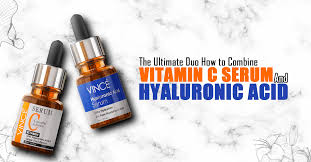
Can I Use Hyaluronic Acid with Retinol and Vitamin C?
It’s no secret that hyaluronic acid, retinol, and vitamin C are some of the most popular and effective ingredients in modern skincare.
But with great power comes great responsibility—and if you don’t know how to layer these active ingredients properly, you could end up with irritation, redness, dryness, or all three.
So, can you safely use hyaluronic acid with retinol and vitamin C?
Yes, you absolutely can—as long as you know when and how to use them.
Let’s break it down and answer your most frequently asked questions to help you build a routine that gets results without upsetting your skin.
How Do Retinol, Vitamin C, and Hyaluronic Acid Work Together?
Each of these ingredients plays a unique role in your skincare routine, and when used properly, they complement each other beautifully.
Vitamin C (L-ascorbic acid or derivatives):
A powerful antioxidant that brightens skin
Fights free radical damage from sun and pollution
Stimulates collagen and fades dark spots
Retinol (Vitamin A derivative):
Encourages cell turnover and collagen production
Reduces fine lines, wrinkles, and acne
Improves skin tone and texture
Hyaluronic Acid:
A hydrating humectant that draws moisture into the skin
Plumps and smooths the complexion
Helps reduce irritation and flakiness from potent ingredients like retinol
Used together correctly, hyaluronic acid hydrates, vitamin C protects and brightens, and retinol renews and smooths.
What’s the Best Way to Use These Ingredients in a Skincare Routine?
To avoid irritation and maximize results, you need to understand timing and layering.
🕙 Morning Routine:
Cleanser
Vitamin C serum (protects skin during the day)
Hyaluronic acid (locks in hydration)
Moisturizer
SPF 30+ (crucial when using vitamin C and retinol!)
🌙 Evening Routine:
Cleanser
Hyaluronic acid serum (applied to damp skin)
Retinol (serum or cream)
Moisturizer (preferably something calming and barrier-repairing)
💡 Bonus tip: If you’re new to retinol, start with 2-3 nights a week and gradually build up to daily use to avoid irritation.
Which Comes First: Hyaluronic Acid, Vitamin C, or Retinol?
Let’s clarify this by looking at both timing (AM vs. PM) and product consistency (thin to thick).
✔️ Morning:
Vitamin C goes first (usually a thin serum)
Hyaluronic acid comes next (often a thicker gel serum)
Followed by your moisturizer and sunscreen
✔️ Evening:
Hyaluronic acid first (on damp skin)
Retinol second (as it’s usually a cream or oil-based serum)
Finish with moisturizer to lock everything in
Always remember: Apply products from thinnest to thickest for best absorption.
Should I Use Hyaluronic Acid Before or After Retinol?
Use hyaluronic acid before retinol—this helps buffer the retinol’s strength and protects the skin barrier. Think of hyaluronic acid as your skin’s hydration insurance.
When you apply it to slightly damp skin, it acts like a sponge, pulling in water and prepping your skin to better absorb retinol, without the dreaded dryness or irritation.
Can I Use Vitamin C and Retinol Together?
Technically, yes—but for most skin types, it’s not recommended to layer them at the same time. Here’s why:
Both can be drying or irritating, especially for sensitive skin
They work best in different pH environments
Layering them may reduce effectiveness or cause redness, flaking, or breakouts
Best approach:
Use vitamin C in the morning (for antioxidant protection and glow)
Use retinol at night (for skin regeneration while you sleep)
This way, you get the benefits of both ingredients—without overwhelming your skin.
Should Retinol Be Used Before or After Serum?
It depends on the type of serum you’re using.
If the serum is hydrating or soothing (like hyaluronic acid or niacinamide), apply it before retinol.
If the serum is active or exfoliating (like an AHA/BHA serum), avoid layering it with retinol altogether—this can irritate and damage your skin.
✔️ Layering tip:
Cleanse, Hydrating serum (HA or niacinamide), Retinol, Moisturizer
Can Hyaluronic Acid Be Mixed with Retinol?
Yes, and it’s a match made in skincare heaven.
Hyaluronic acid:
Hydrates deeply
Buffers the retinol effect
Soothes dryness, tightness, and peeling
When used together, retinol works on cell turnover while hyaluronic acid ensures your skin stays hydrated and resilient.
Should I Apply Hyaluronic Acid Before or After Moisturizer?
Before.
Apply hyaluronic acid to slightly damp skin, then follow up with a moisturizer to seal it in. Without this sealing step, HA can pull moisture out of your skin—especially in low humidity environments.
💧 Hyaluronic acid = hydration magnet
🧴 Moisturizer = hydration seal
Together, they keep your skin smooth, plump, and protected all day.
Should I Use SPF When Using Retinol and Vitamin C?
Yes—every single day.
Even if it’s cloudy, raining, or you’re indoors. Here’s why:
Vitamin C makes your skin more sensitive to sunlight
Retinol increases photosensitivity, which can cause sunburn, irritation, and hyperpigmentation if unprotected
Apply a broad-spectrum sunscreen (SPF 30 or higher) every morning after your moisturizer. Reapply every 2 hours if you’re outdoors.
Final Thoughts: Can You Use Hyaluronic Acid with Retinol and Vitamin C?
Yes, you can! But timing, product order, and balance are essential.
🛠️ Here’s your cheat sheet:
Ingredient When to Use Order in Routine Key Benefits
Vitamin C Morning After cleansing Brightens, protects, firms
Hyaluronic Acid AM + PM After cleansing/toner Hydrates, plumps, soothes
Retinol Evening After HA Smooths, regenerates, fights aging
Moisturizer AM + PM Last step Locks in hydration and actives
SPF Morning Final step Protects against UV + free radicals
With consistency and patience, this trio can completely transform your skin—giving you that hydrated, smooth, radiant glow we all want.
If you’re unsure where to start or have sensitive skin, always do a patch test or consult with a dermatologist.
And if you found this guide helpful, don’t forget to follow us on Instagram or send a DM—we love answering your skincare questions!
DQH Knowledge drop: In your 20s, your skin cell turnover decreases. (Cell turnover is a key component in keeping your skin youthful.) You know what else slows down? Your collagen production. Starting in your 20s, collagen decreases by about 1 percent per year. Should you want to prevent fine lines and wrinkles, start by eliminating behaviors that contribute to premature aging. “If it’s bad for you, it’s bad for your skin,” says dermatologist Michel Somenek.
“Cigarette smoking reduces blood flow to the skin and causes premature wrinkling and a dull skin texture. Making the repeated pursed motion to inhale can also cause smoker’s lines. Alcohol and recreational drugs are toxins for the skin that damage its cellular structure and DNA,” Somenek tells us. “The faster you eliminate vices while you are young, the better chance your skin and body have to recuperate.” Also, adopting an anti-aging routine in your 20s is key. After all, the best offense is a good defense. We spoke to Somenek and experts Joshua Ross and Audrey Kunin to find out more.
Keep reading for the best anti-aging products for your 20s, according to skincare professionals.
Sunscreen
“We all know that the sun is the number one cause of skin aging and starting the prevention in your 20s is very important,” Ross says. “The majority of your sun damage won’t start to appear until you’re in your 30s, so don’t wait until you see it surface or you’ll be behind the curve. Stay ahead of it with a good-quality zinc-based sunscreen worn daily.”
Farmacy Green Defense Daily Mineral Sunscreen
An invisible sunscreen with SPF 30, plus botanical extracts meant to protect skin with tons of antioxidants. Bonus: It’s clean and fine to use under makeup.
Bareminerals Complexion Rescue™ Tinted Moisturizer Broad Spectrum SPF 30
Although we recommend you use your SPF and moisturizer separately, we also understand moments when you don’t have time or energy for that extra step. For those times, this bareMinerals moisturizer is a great thing to have on hand.
Vitamin C Serum
“A great introduction to anti-aging is to start with a vitamin C serum in your morning skincare routine,” Ross says. “It’s a powerful antioxidant that will neutralize free radicals and brighten the skin.” He adds that it’s a great way to counteract the effects of the sun’s harmful rays, which, as previously mentioned, are among the biggest causes of premature aging.
Drunk Elephant C-Firma™ Vitamin C Day Serum
The Drunk Elephant C-Firma is a lightweight serum that promises to give skin a glow by combining the brightening powers of vitamin C with ferulic acid, l-ascorbic acid, and vitamin E. The included sodium hyaluronate is meant to replace hydration loss, so you shouldn’t have to deal with any irritation.
Sunday Riley C.E.O. Rapid Flash Brightening Serum
This potent serum is jam-packed with vitamin C (15 percent, to be exact), which means it’s a potential superstar at both brightening skin and dousing it in antioxidants.
Peptides
Using peptides on your skin has many benefits, says Somenek. “The skin barrier is what defends the body against pollution, UV rays, bacteria, and toxins. It can be damaged by several everyday factors. Using topical peptides aids in building a stronger barrier,” he says. “Peptides comprise elastic fibers, which are a type of protein. These fibers help to make skin appear taut and firm. Peptides can also help repair damaged skin, relieve inflammation, and even out skin tone. Some peptides can kill acne-causing bacteria that is common in 20-somethings.”
Kunin agrees, saying, “Peptides are an excellent entry point for supporting collagen.” She recommends looking for face and eye treatments that contain these collagen-boosting powerhouses.
Charlotte Tilbury Magic Eye Rescue Cream
This Charlotte Tilbury super-emollient eye cream has a base of coconut oil and shea butter (read: it’s incredibly hydrating). Botanicals plus peptides are meant to help reduce dark circles and boost collagen, respectively.
This creamy moisturizer serves up potent collagen-boosting peptides and pycnogenol, and antioxidant-rich vitamin C. “Instead of sitting on top of the skin, peptides penetrate the outer layer so they go deep. The ‘signals’ they send tell the cells to produce elastin and collagen, which are needed for youthful-looking skin,” explains Somenek.
At-Home Peel Pads
Remember that skin cell turnover fiasco we talked about earlier? One way to help support it is by exfoliating. “Exfoliation is important to help keep skin fresh and luminous,” Kunin says. She recommends using at-home peel pads as an easy and effective way to exfoliate.
“The goal in your 20s is to fight the slowing pace of cell turnover. It is wise to use products that gently exfoliate, yet still remove oil and other impurities. Products that have Alpha Hydroxy Acids (AHA) or Beta Hydroxy Acids (BHA) are a good choice.”
According to Somenek, you should only exfoliate two to three times a week. “People of all ages are guilty of over-exfoliating and that can be too much of a good thing,” he says.
Dermadoctor Kakadu C Intensive Vitamin C Peel Pad
A few swipes of this Derma Doctor powerful peel pad promise to leave your skin glowing and smooth, thanks to the seven (yes, seven) types of chemical exfoliants, including AHA and BHA. It also contains vitamin C via Kakadu plum extract for added brightening and antioxidant protection.
KEY INGREDIENTS Kakadu plum extract is sourced from the Kakadu plum, a fruit grown in northern Australia. It contains vitamin C, which restores the skin’s natural barrier, increases collagen production, and soothes irritation.
Dr. Dennis Gross Skincare Alpha Beta® Universal Daily Peel Pads
These are the gold standard of peel pads, with a cult following and over 900 five-star reviews on Sephora. They’re easy to use and contain a blend of anti-aging exfoliating acids.
Emollient Night Cream
“In your 20s, you need to start upping the hydration in your skincare routine. You may have been cautious of over-moisturizing because of acne in your teens, but as you enter your 20s, your skin transitions and becomes drier,” Ross says. “I recommend an emollient night cream added into your evening skincare regimen.”
“Twenty-somethings need to make sure that they are not using creams that will clog their pores and cause excess oil production,” says Somenek. Opt for non-comedogenic products.
Cerave Skin Renewing Night Cream
One great choice is the CeraVe Skin Renewing Night Cream, which is a non-comedogenic night cream that leaves skin soft and glowy. It combines the moisturizing powers of ceramides and hyaluronic acid.
RoC Retinol Correxion Max Hydration Creme
“The best night cream ingredients contain retinol, benzoyl peroxide, and/or salicylic acid or hyaluronic acid. The goal is to moisturize, yet remove excess oil,” says Somenek. This Roc Retinol Correxion cream fits the bill as it contains both hyaluronic acid and retinol so it promises to moisturize while also being non-comedogenic.



